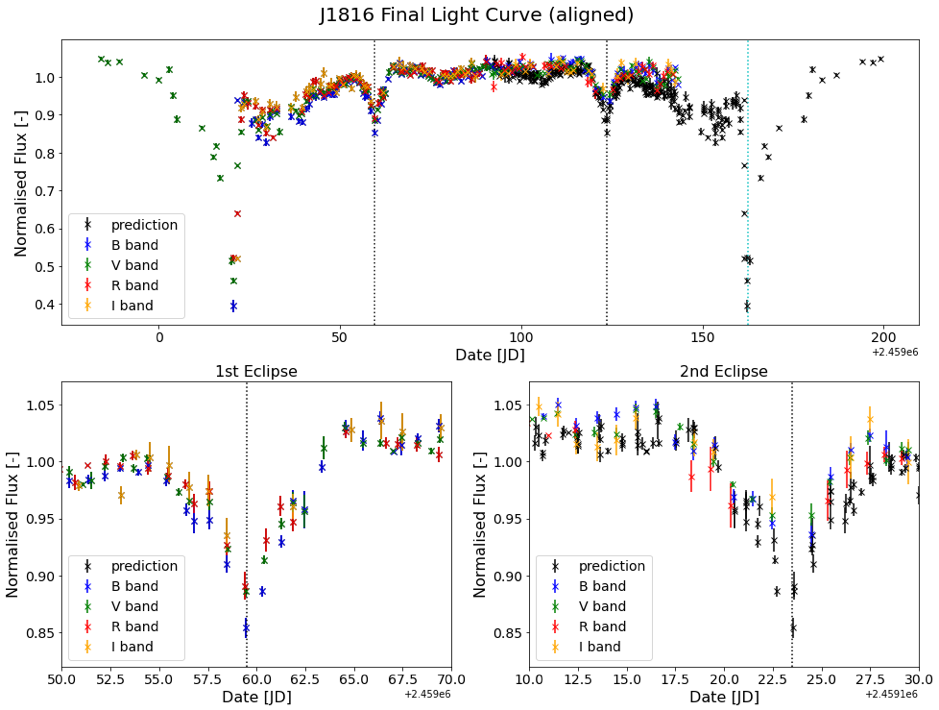October 28, 2020
AAVSO Forum threads (scroll to the bottom of a thread for latest posts):
- Campaigns and Observation Reports: https://www.aavso.org/asassn-v-j181654-202117-campaign
- Young Stellar Objects: https//www.aavso.org/asassn-v-j181654-202117-campaign-01
Please subscribe to these threads if you are participating in the campaign so you can be updated by the astronomers and by HQ. Join in the discussion or ask questions there!
Dirk van Dam (Leiden Observatory) and Dr. Matthew Kenworthy (Leiden Observatory) request AAVSO observer assistance in monitoring the UXOR ASASSN-V J181654.06-202117.6 in an exoplanet/planetary system study. This system was the target of AAVSO Alert Notice 710.
van Dam writes: "This system is a recently discovered system by ASAS-SN, which shows a very deep eclipse (0.8 mag ~ 50%), that is not only asymmetric (indicative of a circumplanetary disk), but also exhibits substructure (could possibly be rings, or indicative of moon formation). AAVSO Alert Notice 710 shows the initial request for AAVSO data and the data provided has been exquisite and provided further evidence for an eclipsing ring system. The plot below shows a prediction for the light curve evolution and how AAVSO data has been following the prediction.

“A new alert for this star is being sent out because the star is setting for the season. The blue line cyan line is on the 9th of November 2020, where the light curve is expected to drop down substantially, but this also corresponds with the setting of the star for the season. While the star is still visible on the 9th of November 2020, in many locations it is only visible below 40° altitude (airmass > 2). Despite the increasing effects of the atmosphere, observations are tantamount to the proof of a symmetric light curve. The potential follow-up campaign (headway is being made on this) would be to again catch the whole eclipse and constrain the period of the system."
Observations were made at Las Cumbres Observatory in Chile. AAVSO observers are requested to begin monitoring the target now and continue for 20 days after the target has returned to its quiescent level (V~13.3).
CCD photometry is requested (filters in order of priority: Sloan g, V, B, Rc, Ic). If observing with multiple filters, alternating filters is preferred. Filtered photometry is preferred, but if unfiltered observations are made, they should be reduced to a V filter (CV). Visual observations are also welcome.
Regarding the cadence of CCD observations, van Dam says: "There seems to be at least nightly variation of the target, but shorter cadence is preferred to fill out the light curve well. Several observers have already provided very high cadence data that have revealed a complex set of pulsations that have been modelled to a reasonable degree. The shorter the cadence the better, with a minimum of twice per night. Time series would be the best and every hour would be fantastic, with a minimum SNR of 5.
"New to this report is the request for spectroscopy. As can be seen from the image included, the depth of the 1st eclipse (bottom left panel) is colour dependent (B band is ~ 3% deeper than R band). This is indicative of dust and with high resolution spectroscopy we can determine what the composition of the occulting object is. The request is therefore for spectroscopy on the 9th of November 2020 (during the deepest part of the eclipse as this includes the most of the occulting material) and then once the star has become quiescent (we might have to wait for the next season for this)."
Observers are requested to include the airmass value for each observation. The astronomers also need to know the location of each observer's telescope, so if you have not filled out the AAVSO's Site and Equipment webpages, please be sure to do so before submitting data on this star. You may also access these pages from your My account page.
van Dam communicates that observers providing sufficient and useful data (spectroscopic and photometric) will definitely be considered for co-authorship.
For further details on the progress of the analysis (plots and descriptions of the steps undertaken) see https://github.com/dmvandam/j1816/tree/master/public
Note that ASASSN-V J181654.06-202117 has been the subject of ATel #13818 (Z. Way et al.).
Coordinates (J2000): R.A. 18 16 54.06 Dec. -20 21 17.5 (from VSX entry for target)
Charts with comparison stars for ASASSN-V J181654.06-202117.6 may be created using the AAVSO Variable Star Plotter (VSP).
Submit optical observations: Please submit photometry and visual observations to the AAVSO International Database using the name ASASSN-V J181654.06-202117.6.
Submit spectroscopic observations: Please submit spectroscopic observations to the AAVSO Spectroscopy Database (AVSpec).
This AAVSO Alert Notice was compiled by Elizabeth O. Waagen using material supplied by Dirk van Dam.
------------------------------------------------
SUBMIT OBSERVATIONS TO THE AAVSO
Information on submitting Optical and Spectroscopic observations to the AAVSO may be found at:
https://www.aavso.org/webobs
ALERT NOTICE ARCHIVE AND SUBSCRIPTION INFORMATION
An Alert Notice archive is available at the following URL:
https://www.aavso.org/aavso-alert-notices-for-observing-campaigns-and-di...
Subscribing and Unsubscribing may be done at the following URL:
https://www.aavso.org/aavso-alert-notice-subscribe
-------------------------------------------------
Please support the AAVSO and its mission -- Join or donate today:
https://www.aavso.org/apps/donate/

